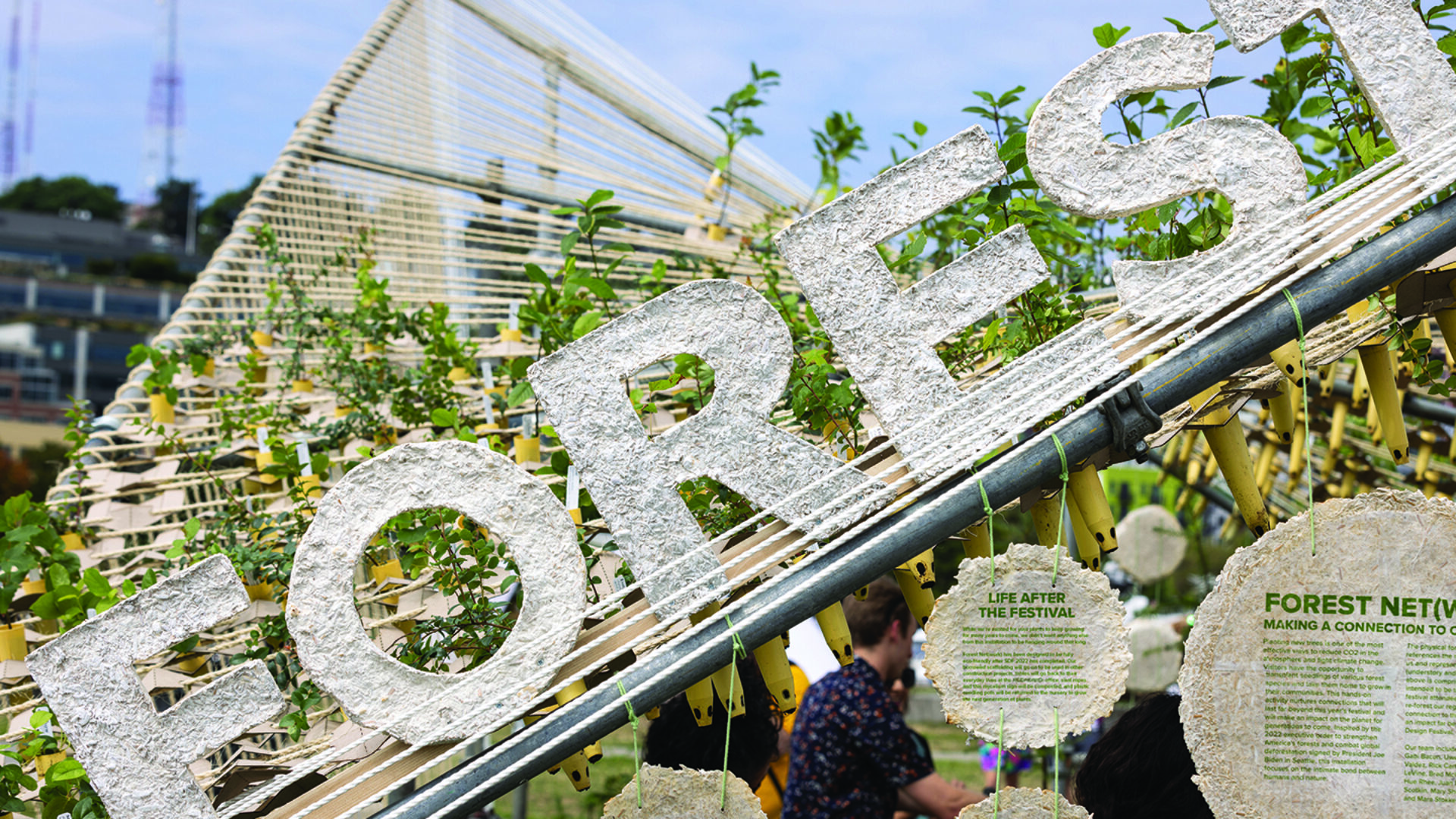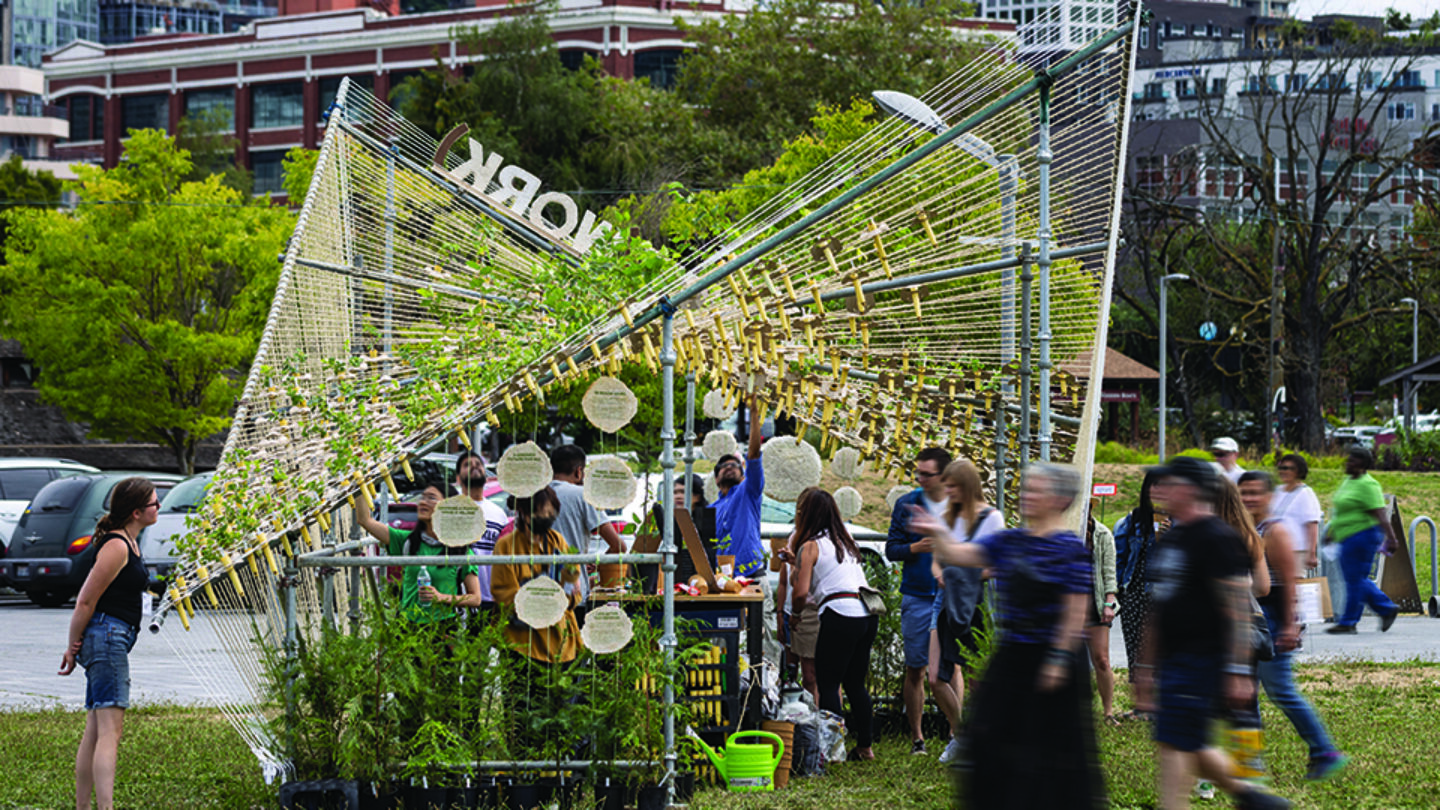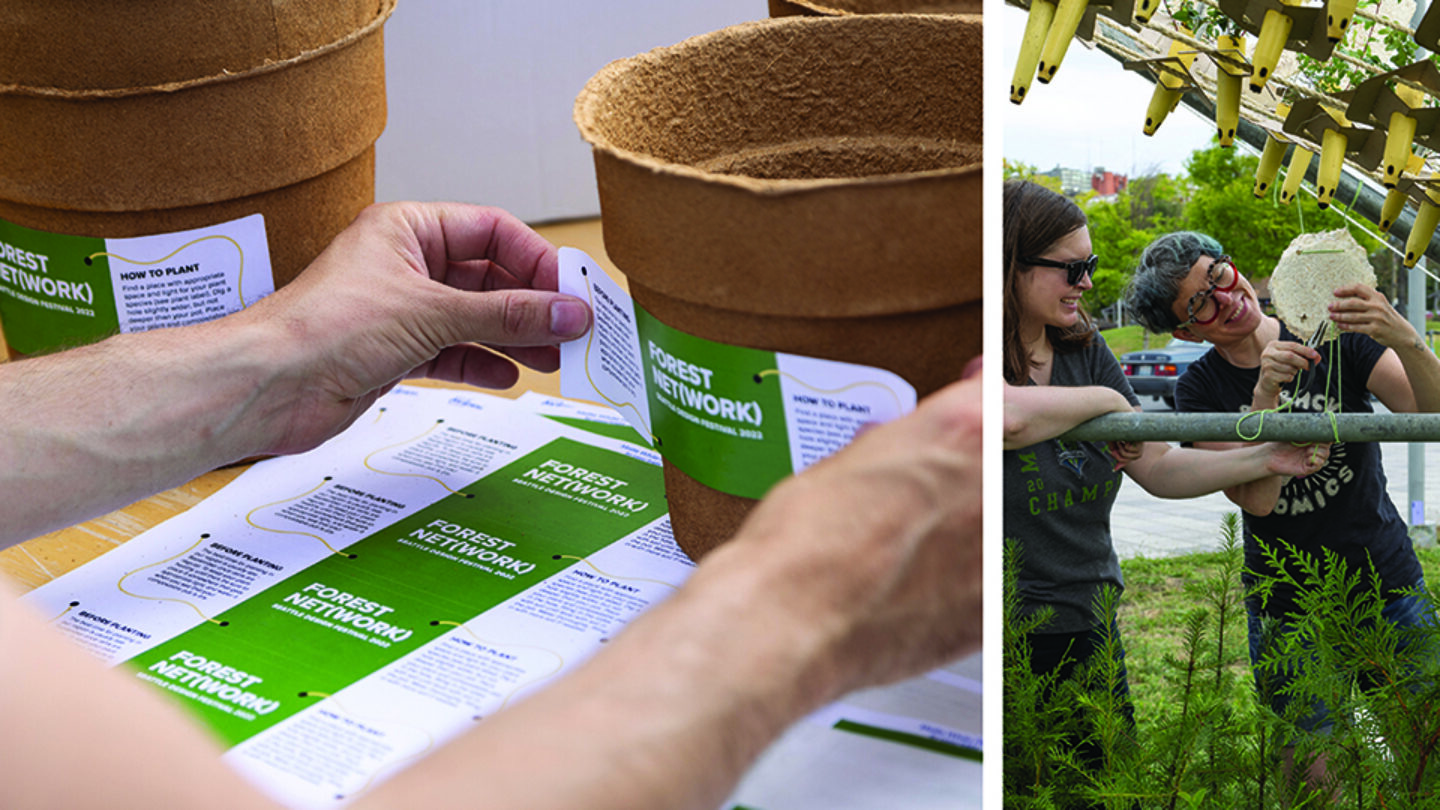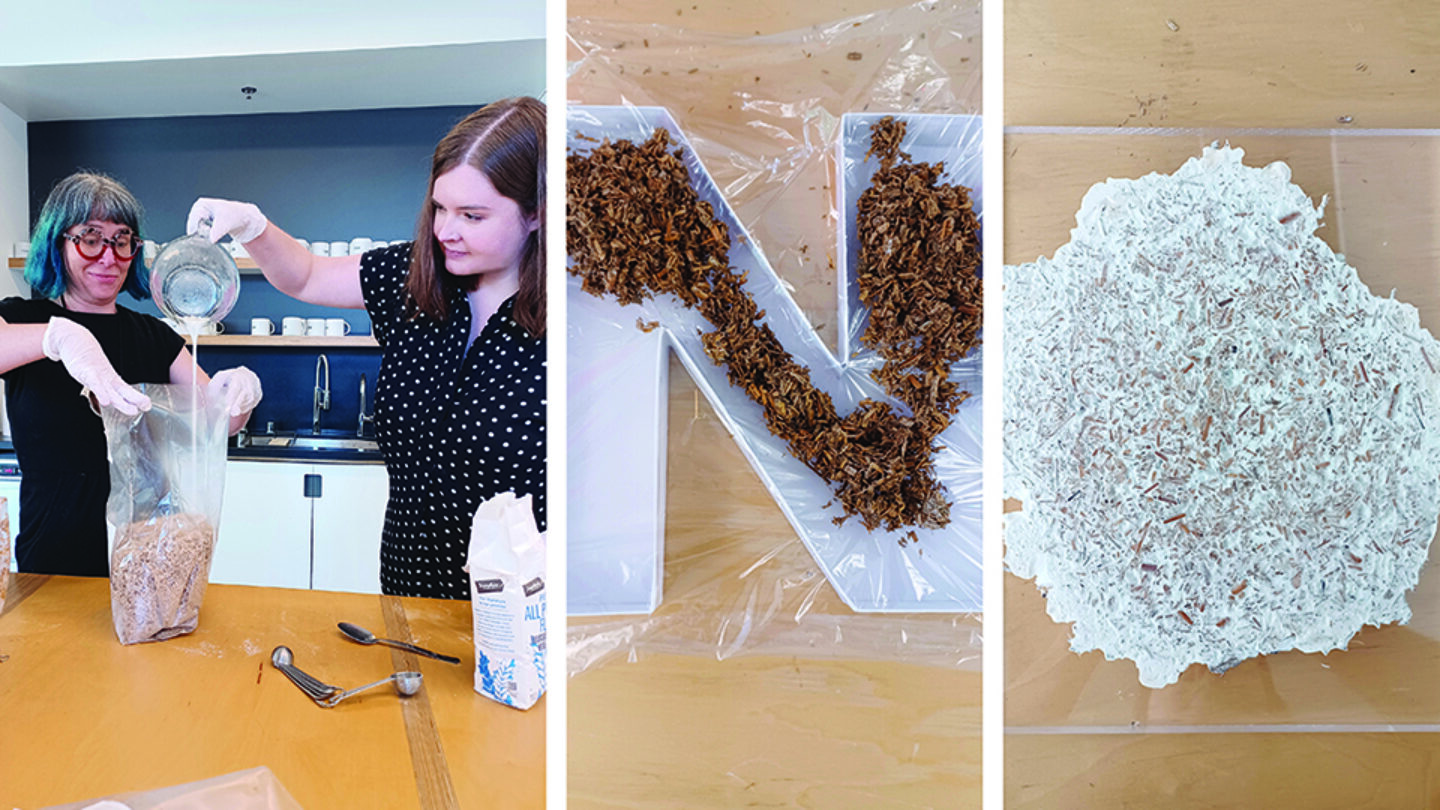Forest Net(work)
A unique, zero-waste exhibit designed, fabricated, grown and donated by NBBJ, Berger Partnership and GLY Volunteers

The Challenge
Seattle Design Festival brings design to the masses, encouraging thousands of visitors annually to participate in public dialogue and community engagement about the role and impact of design in urban life. For the 2022 prompt of ‘Connection,’ the team of volunteers focused on forging a deeper connection between visitors and the earth. Thirty-four volunteer architects from NBBJ, landscape designers from Berger Partnership, horticulturalists, NBBJ experiential designers, and contractors from GLY partnered together for a 99% waste-free installation honoring the Puget Lowlands Forest biome by giving away 600 trees, shrubs, and ground covers for festival goers to take home and plant in their communities.
Attendees of the Seattle Design Festival engage with dozens of thought-provoking installations and interactive activities that utilize design thinking strategies to address challenges facing various communities throughout the region. Stand-out projects draw extra awareness to their causes and compel visitors to continue thinking critically about issues after the festival concludes. The NBBJ collective team wanted to be one of these contributors and so centered our installation around an idea that by its nature is long-lasting and actively bettering the world with little effort from the attendees: planting drought-tolerant trees and plants native to our biome.
Project Vision
Inspired to create a deeper connection to the world we all share, as well as the knowledge that we need to make more sustainable decisions to support that connection, this team of volunteers from NBBJ, Berger Partnership and GLY sought to create an installation at the Seattle Design Festival that would have a net-positive climate impact as well as a social impact.

Storytelling signage engaged attendees waiting to choose their plant, explaining the installation’s purpose and interesting information about our biome, mycelium, sustainability, and reforestation.
Sean Airhart

Paper labels applied to each biodegradable Fertilpot gave instructions for proper care and planting, while mycelium discs told stories of our local biodiversity, reforestation benefits, and our sustainability focus.
Sean Airhart
Design + Execution
Because one of the main design drivers was to provide maximum visual impact with a minimal environmental footprint, hitting the mark on a temporary building structure, visitor experience and flow were at the forefront.
The team studied a variety of parabolic building forms using scaffolding to mimic the peaks of nearby mountains, paying attention to clearances needed for accessibility and creating an inviting experience that would feel open and airy, but also reminiscent of being in the forest with canopy overhead. Ropes tensioned over the scaffolding support custom-designed biodegradable chipboard plant holders that lifted the smaller plants up, providing the dappled light of tree cover and a bit of shade on a summer weekend.
Months before the festival, the team started growing our own signage from mycelium and hemp hurd agricultural byproduct. 1’-0” cap height molded letters were attached to the scaffolding as the identity signage along with two moss parentheses. Various sized and organically shaped discs received wheat-pasted prints about reforestation, the Puget Lowlands Forest biome, how the installation would break down after the festival, and how the signage materials themselves were created.
At the festival, guests were encouraged to choose a plant that was right for their available outdoor spaces and repot their plant into a biodegradable Fertilpot that could be planted directly into the earth. Volunteer staff helped provide information about growing conditions, reforestation initiatives, the importance of biodiversity and native species, and the sustainability components of the installation itself.
“Our goal was to create a unique, zero-waste exhibit with positive (and fun) community engagement” says Eric LeVine, Principal at NBBJ Design: Experience Design / Environmental Graphics.
Forest (Net)work was thoughtfully designed to be momentary, visually compelling, immersive, and 99% reusable, recyclable or compostable:
- Identity and informational signage elements were comprised of molded mycelium letters and discs (grown in-house by our designers), rice paper, wheat paste, and cotton cording. All signage components were composted after the installation. Cardboard letterforms used for mycelium molding were given away to team volunteers; letterforms not taken home were recycled.
- Supporting scaffolding was loaned to the project without cutting custom sizes of pipes so that all pieces could be reused on future job sites. Ladders used in set-up/take-down were also loaned by the contractor.
- Planting tables were borrowed from the NBBJ design office. Standing height tables and sitting height tables were both used to make the installation more accessible.
- Plants were repotted in Fertilpots, wood fiber biodegradable pots designed to be potted into the ground and to decompose, providing nutrients to the new plant. The original plastic plant containers and trays were returned to the nursery, who confirmed that they do regularly reuse returned pots. The boxes which the Fertilpots were shipped in were recycled. Repotting instruction signs and care labels were printed on compostable paper.
- Jute and cotton tension ropes were donated to a local maritime museum.
- Chipboard plant hangers designed specifically for this installation were laser cut at our in-house model shop and were commercially composted.
- Gardening implements were loaned by horticulturalists and designers, including water containers and gloves.
- Total waste: 36 yards kitchen plastic wrap (used in mycelium molding process), 16 plastic bags (formerly containing potting soil and mycelium starter).
This pro-bono project was made possible with donations of time, materials and expertise from NBBJ, Berger Partnership, and GLY. Signage components were grown in-house by the NBBJ EGD design team and baked in our home kitchens; plant holders were fabricated by NBBJ’s in-house model shop; scaffolding erected by GLY; ropes tensioned by GLY and NBBJ architecture team; plants installed by NBBJ and Berger Partnership. All three partners helped with take-down and getting components ready for reuse or recycling/composting.
“Signage components were grown in-house by the NBBJ EGD design team and baked in our home kitchens,” says Mara Stokke, Associate at NBBJ Design, Environmental Graphics & Experiential Design.

Our team of volunteers tensioned jute ropes onto a borrowed scaffolding framework to support custom designed sapling holders. Scaffolding and ropes were later reused, while plant holders were recycled.
Sean Airhart

Live mycelium was grown to form dimensional letters and organically shaped sign plaques, then baked to stop growth. All these components were composted after the festival.
Brooke Shary, Mara Stokke

It took a team of 34 volunteers to envision, detail, grow, install, staff, and dismantle this installation responsibly.
Sean Airhart
Project Details
Humans love festivals, but the production typically generates a lot of waste. This temporary installation is genuinely provocative. It proves we can have beautiful temporary structures and signage for gatherings and festivals with biodegradable materials.
An inspiring example of how we can design in harmony with natural systems. Everything about this work is circular — thoughtfully considered from cradle to grave. Materials were either biodegradable or borrowed, compostable, reused or recycled. Instead of fabricating the signage, they grew it! Visitors are inspired to plant native trees, while the broader design community are inspired to be more thoughtful and circular in their own work.
This project really embodied the spirit of the Sylvia Harris Award. This is a small project with a big impact. The designers took sustainability to heart in the creation of this project. The jurors were impressed by the growth of the lettering that was both zero waste and created a beautiful form. The sustainable mission and how the artists used form and space to educate the public was really successful.
A case study on how ecologically responsible design can be structurally beautiful and educate through community participation. Mushroom letterforms! We need to be experimenting with new materials and techniques that celebrate the process, not hiding it under harmful veneers.
Design Team
NBBJ EGD: Eroyn Franklin, Eric LeVine, Cari Scotkin, Mara Stokke (designer)
NBBJ Architecture: Gabi Bacon, Uwe Bergk, Josep Campoy Valdez, Hue Rhee, Juan Rodriguez Lopez, Mary Shook, Miles Stemper (designer)
NBBJ Model Shop: Eric Ryder (fabrication)
NBBJ Facilities: Logan Swan (logistics)
Berger Partnership: Jonathan Morley (landscape designer)
GLY: Rick Carte, Brad McGuirt (logistics)
Collaborators
NBBJ (Design Fabrication)
Berger Partnership (Landscape Designer)
GLY (Logistics)
Photo Credits
Sean Airhart, NBBJ Design
Open Date
2022





